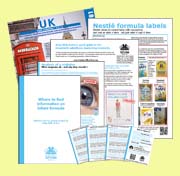Follow-on milks and baby food claims to be debated at Codex meeting in Germany
The Business of malnutrition: breaking down trade rules to profit from the poor
Click here for the press release following this meeting:
http://info.babymilkaction.org/pressrelease/pressrelease24nov110
Day 1 - Saturday 12 November
I am attending the Codex meeting in Bad Soden, Frankfurt this week, wearing the IACFO hat, along with IBFAN colleagues from Swaziland, Canada and Luxembourg. See below for our comments on the agenda items.
Saturday 12.11.11 Bad Soden, Frankfurt, Germany
During the Working Group on the Guidelines on Formulated Supplementary Foods for Older Infants and Young Children - there was general confusion about precisely what products were being referred to, which ones were already covered by other standards, why the guidelines were necessary, why there couldn't be one simple standard for all complementary foods and why industrial by-products used as animal feed and fertiliser such as 'defatted cotton seed flour' were included as ingredients and how such a mixed bag of foods could be described as having ' improved nutritional quality.' Despite all these worries, the Global Alliance for Improved Nutrition (GAIN), continued its call for the constraints on promotional claims to be loosened. (1)
Botswana, Brazil, IBFAN, IACFO and ILCA called the International Code and the WHA Resolutions about complementary foods and claims to be referenced (2). Australia followed through with the suggestion that the specific sections of the Resolutions be lifted out so that there was no confusion. As IACFO I listed them and read out WHA Res 55.25 that calls on Member States, as a matter of urgency "to ensure that the introduction of micronutrient interventions and the marketing of nutritional supplements do not replace, or undermine support for the sustainable practice of, exclusive breastfeeding and optimal complementary feeding" and then called for clearer information in the Nutrition Panel on the back of the label instead of claims.
Barbara Schneenan, Director of the FDA Office of Nutrition, Labeling and Dietary Supplements speaking for the US, said that it was not necessary to refer to the Code because all these items stood on their own, were advice to governments, were used by governments and did not need repeating. Basil Mathioudakis, speaking for the EU, said we would waste a lot of time on this, so to cut it short he said that the EU is opposed to any mention of the WHO Code or Resolutions - that they stand on their own and "Member States and Member countries can do what they want."
I am once again sitting next to the Global Alliance for Improved Nutrition (GAIN) the Swiss Gates-funded alliance. GAIN and its Business Alliance is "dedicated to promoting market-based solutions which address malnutrition"
Can babies have too much iron?
Click HERE for a new study about iron-fortification from Chile that found that infants with high iron levels at 6 months, who were fed iron-fortified formulas had IQ levels 10 points lower at the age of 10 years than infants who had low-iron levels.
Iron-Fortified vs Low-Iron Infant Formula Developmental Outcome at 10 Years Betsy Lozoff, MD; Marcela Castillo, PhD; Katy M. Clark, MA; Julia B. Smith, EdD Arch Pediatr Adolesc Med. Published online November 7, 2011.
CICK HERE for a Reuters report: http://www.reuters.com/article/2011/11/12/us-iron-babies-idUSTRE7AB02820111112
Click Here for a Canadian article about claims 11.11.11: Government allows infant-formula claims despite 'no acceptable evidence'
IBFAN Comments on the Agenda Items
Agenda Item 6 CLICK HERE for our comments on the Guidelines on Formulated Supplementary Foods for Older Infants and Young Children (CAC/GL 8-1991)
We are concerned that this proposal promotes a market-led approach to address malnutrition that will be exploited by industry and that the use of health and nutrition claims will undermine breastfeeding and sustainable, indigenous nutritious foods.
Agenda Item 8 CLICK HERE for comments on the Proposal to Review the Codex Standard for Follow-up Formula (CODEX STAN 156-1987) (Agenda Item 8)
We believe that there is no nutritional need for formulas to be marketed especially for older babies, so no need for a separate standard which would legitimise them. The marketing and composition requirements of existing products can easily be accommodated as a footnote in the infant formula standard. The arguments put forward by New Zealand are based on expanding the market for these unnecessary and expensive products.
CLICK HERE for our comments on the proposal to Include a New Part B for Underweight Children in the Standard for Processed Cereal- Based Foods for Infants and Young Children (CODEX STAN 74- 1981) (Agenda Item 7) IBFAN has several concerns about this proposal.
Here are the Resolutions that Botswana and Brazil wanted to be referenced.
WHA Resolution 49.15 (1996) which:
(1) to ensure that complementary foods are not marketed for or used in ways that undermine exclusive and sustained breast-feeding;
3. URGES Member States to take the following measures:
Resolution (WHA 55.25) 2002
Recognizing that infant and young-child mortality can be reduced through improved nutritional status of women of reproductive age, especially during pregnancy, and by exclusive breastfeeding for the first six months of life, and with nutritionally adequate and safe complementary feeding through introduction of safe and adequate amounts of indigenous foodstuffs and local foods while breastfeeding continues up to the age of two years or beyond;
2. URGES Member States, as a matter of urgency:
4) to ensure that the introduction of micronutrient interventions and the marketing of nutritional supplements do not replace, or undermine support for the sustainable practice of, exclusive breastfeeding and optimal complementary feeding;
2010 Resolution (WHA 63.23 )
1 Urges member states :
(4) to end inappropriate promotion of food for infants and young children and to ensure that nutrition and health claims shall not be permitted for foods for infants and young children, except where specifically provided for, in relevant Codex Alimentarius standards or national legislation;
Political declaration of the High-level Meeting of the General Assembly on the Prevention and Control of Non-communicable Diseases adopted at the UN General Assembly 19th September 2011
Reduce risk factors and create health-promoting environments
43. Advance the implementation of multisectoral, cost-effective, population-wide interventions in order to reduce the impact of the common non-communicable disease risk factors, namely tobacco use, unhealthy diet, physical inactivity and harmful use of alcohol, through the implementation of relevant international agreements and strategies, and education, legislative, regulatory and fiscal measures, without prejudice to the right of sovereign Nations to determine and establish their taxation policies, other policies, where appropriate, by involving all relevant sectors, civil society and communities as appropriate and by taking the following actions:
(f) Promote the implementation of the WHO Set of recommendations on the marketing of foods and non-alcoholic beverages to children, including foods that are high in saturated fats, trans-fatty acids, free sugars, or salt, recognizing that research shows that food advertising to children is extensive, that a significant amount of the marketing is for foods with a high content of fat, sugar or salt and that television advertising influences children’s food preferences, purchase requests and consumption patterns, while taking into account the existing legislation and national policies, as appropriate;
(g) Promote the development and initiate the implementation, as appropriate, of cost-effective interventions to reduce salt, sugar and saturated fats, and eliminate industrially produced trans-fats in foods, including through discouraging the production and marketing of foods that contribute to unhealthy diet, while taking into account existing legislation and policies;
……..
(i) Promote, protect and support breastfeeding, including exclusive breastfeeding for about six months from birth, as appropriate, as breastfeeding reduces susceptibility to infections and the risk of undernutrition, promotes infant and young children’s growth and development and helps to reduce the risk of developing conditions such as obesity and non-communicable diseases later in life, and, in this regard, strengthen the implementation of the international code of marketing of breast milk substitutes and subsequent relevant World Health Assembly resolutions;
| Attachment | Size |
|---|---|
| IBFAN on Supplementary 11.pdf | 92.25 KB |
| IBFAN on India underweight 11.pdf | 289.05 KB |
| IBFAN IACFO Item 8 NEW.pdf | 375.37 KB |
- Login to post comments






